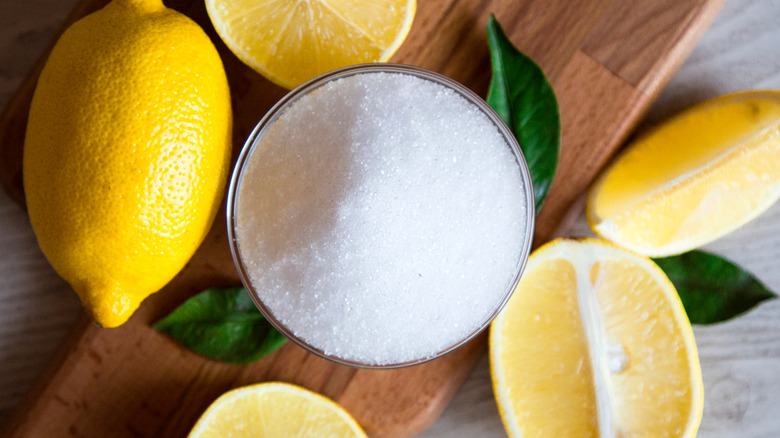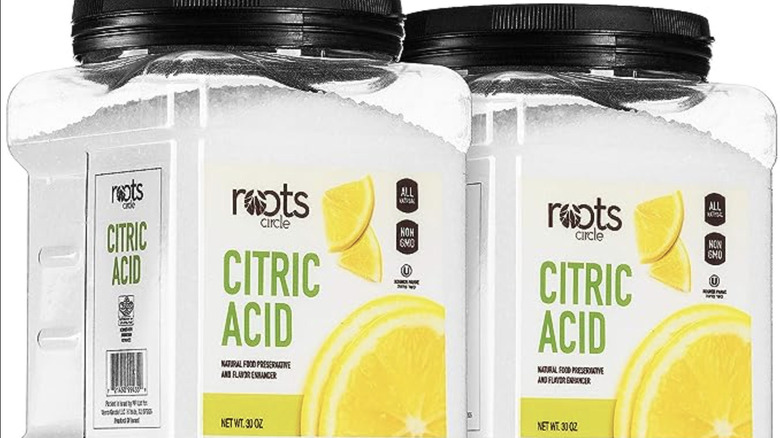The Acid Combos That Give Sour Candy Its Bite
We may receive a commission on purchases made from links.
Sour candy is a favorite childhood treat and a nostalgic one for many adults who, incidentally, still slip those pucker-perfect treats into grocery carts. It's not just the nostalgia; There's a real draw to the sweet and sour combination in food, evidenced by popular savory dishes employing sweet and sour sauces. But rather than using vinegar for the tangy component, candies instead rely on added acids.
Citric acid is by far the most utilized ingredient in those sour gummy bears or worms, lemon drops, buttons, suckers, and dozens of other brand-name assortments. It tends to be more manageable and less extreme than other acid additives in candy, some of which affect flavor and others targeting longevity in the mouth.
Malic acid increases sour candy flavor intensity, while tartaric acid adds a bitter, biting effect. On the other hand, Fumaric acid makes the cutting-edge bitterness last a bit longer, primarily because it takes longer to dissolve. Generally speaking, acids with higher pH levels provide more sour flavor, and sour confections may contain a mix of several food-grade acids.
Sour candy devotees probably aren't considering health benefits, but some do exist. Foods containing citric acid, when eaten in moderation, can offer a helping hand in metabolizing energy, preventing or treating kidney stones, and absorbing health-enhancing minerals such as calcium and potassium, according to Healthline. The benefits, in both health and taste, may vary based on the source of the citric acid.
About that citric acid
Given that citric acid is the more common substance providing the punchy power of sour candies, it's worth mentioning where it originates. First of all, it's fully approved for human consumption and appears in countless food products, including candies and drinks, as well as in pharmaceuticals and cleaning products. But two versions of citric acid exist, one that's naturally occurring and one that emerges from fermentation.
Citric acid from Mother Nature, as the name suggests, comes from citrus fruits, primarily lemons but also limes, oranges, and even some berries and tomatoes. This type of natural acid is the gold standard, but it's far from being the most prevalent in sour candy-making. In fact, it likely comprises as little as 1% of citric acid in commercially available foods today.
The second type of citric acid still has a natural component, albeit one with far less surface appeal. That would be black mold, specifically a variety known as aspergillus niger. During a microbial fermentation process, carbohydrates such as sugar, molasses, or cornstarch help citric acid grow on the mold. With 99% of citric acid produced this way, it's a safe bet that this method produces the world's most coveted sour candies.
Adding sourness to homemade candies
How citric and other acids get added to hard, soft, crunchy, fizzy, or gummy candies is pretty straightforward. It typically comes in a white powder form that's stirred in during the confection-making process, especially with soft sour candies such as gummy worms. It's usually mixed directly into the sugar, which has a similar consistency.
Some makers, whether professional or home-kitchen confectioners, seek out citric-acid powders with designations such as non-GMO, kosher, or gluten-free. Otherwise, citric acid in powder form is a pretty universal product that's easily accessible and relatively inexpensive.
There is an option for the powder form of citric acid, one that comes in handy when making hard, sour candies rather than soft ones. It's a product known as hard candy flavoring, which comes in a liquid form, bottled for quick and easy candy-making. Also referred to a hard-candy concentrate or flavoring oil, it comes in many sour flavors and varying levels of citric acid for tangier options. Concentrates combine the acids and sugars for no-fuss sweet and sour confections.



